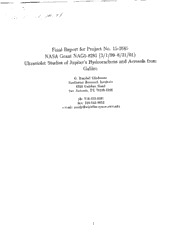
Ultraviolet Studies of Jupiter's Hydrocarbons and Aerosols from Galileo PDF
Preview Ultraviolet Studies of Jupiter's Hydrocarbons and Aerosols from Galileo
,. / //j . / Final Report for Project No. 15-2645 NASA Grant NAG5-8281 (3/1/99-8/31/01) Ultraviolet Studies of Jupiter's Hydrocarbons and Aerosols from Galileo G. Randall Gladstone Southwest Research Institute 6220 Culebra Road San Antonio, TX 78238-5166 ph: 210-522-3581 fax: 210-543-0052 e-mail: [email protected] 1 Introduction and Overview This is the final report for this project. The purpose of this project was to support PI Wayne Pryor's effort to reduce and analyze Galileo UVS data under the JSDAP program. The spectral observations made by the Galileo UVS were to be analyzed to determine mixing ratios for important hydrocarbon species (and aerosols) in Jupiter's stratosphere as a function of location on Jupiter. Much of this work is still ongoing. To date, we have concentrated on analyzing the variability of the auroral emissions rather than the absorption signatures of hydrocarbons, although we have done some work in this area with related HST-STIS data. 2 First Year For the first year, the proposal plan for Co-I Gladstone was to: 1. Obtain current photochemical vertical profiles for hydrocarbons 2. Forward model the spectra with doubling and adding codes, assuming photochemical profiles (with PI Pryor). 3 Second Year For the second year, the plan for Co-I Gladstone was to: 1. Obtain current auroral model profiles for hydrocarbons 2. Forward model the spectra, using auroral vertical profiles (with PI Pryor). In the second year the spectra were analyzed for temporal variability. The H2 emissions mea- sured by the Galileo UVS near 124 nm were found to be highly variable--on time scales of seconds. Emissions at 161 nm varied in phase with the 124 nm emissions but were considerably weaker. The slit-averaged brightness at both wavelengths increased by a factor of 2 on two occasions, for periods of about 100 seconds. The brightness ratio of the two spectral regions was consistent with emission through a slant CH4 column of (3.5 =k0.2) × 1016 cm -2. These rapid variations are likely related to polar cap 'flares' that have been observed with HST. 4 Papers Published Ajello, J. M., D. E. Shemansky, W. R. Pryor, A. I. F. Stewart, K. E. Simmons, T. Majeed, J. H. Waite, Jr., G. R. Gladstone, and D. Grodent, "Spectroscopic Evidence for High-Altitude Aurora at Jupiter from Galileo Extreme Ultraviolet Spectrometer and Hopkins Ultra- violet Telescope Observations," Icarus, 152, 151-171, 2001. Pryor, W. It., A. I. F. Stewart, K. E. Simmons, J. M. Ajello, W. K. Tobiska, J. T. Clarke, and G. R. Gladstone, "Detection of Rapidly Varying H2 Emissions in Jupiter's Aurora from the Galileo Orbiter," Icarus, 151,314-317, 2001. 5 Papers Presented Pryor, W. R., A. I. F. Stewart, K. E. Simmons, J. T. Clarke, J. M. Ajello, W. K. Tobiska, and G. R. Gladstone, "Auroral Flares on Jupiter: Photometry from Galileo UVS and Spectroscopy from HST STIS," 32nd Annum Meeting of the Division for Planetary Sciences of the American Astronomical Society, Pasadena, 2000. Clarke, J. T., G. R. Gladstone, W. R. Pryor, J. M. Ajello, L. Ben Jaffel, J. E. P. Connerney, J.- C. G6rard, J. T. Trauger, and J. H. Waite, Jr., "HST/STIS Observations of a Dawn Auroral Storm on Jupiter," 32nd Annual Meeting of the Division for Planetary Sciences of the American Astronomical Society, Pasadena, 2000.
